Over the years CERN’s photographers have provided an important record of the laboratory’s development. This selection provides a glimpse of CERN’s history through their eyes.
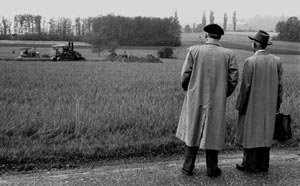
Geneva was selected as the site for the CERN laboratory at the third session of the provisional council in 1952. This selection successfully passed a referendum in the canton of Geneva in June 1953, and on 17 May 1954 the first shovel of earth was dug on the Meyrin site under the eyes of Geneva officials and members of CERN staff.
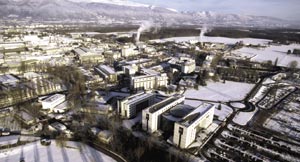
An aerial view of modern-day CERN taken in January 2004 shows how the Meyrin site has developed in 50 years. In the background are the buildings at Point 1 on the Large Hadron Collider (LHC) ring, where the ATLAS detector is being installed. In the foreground is Building 40, which was built to provide offices for the physicists working on the LHC experiments.
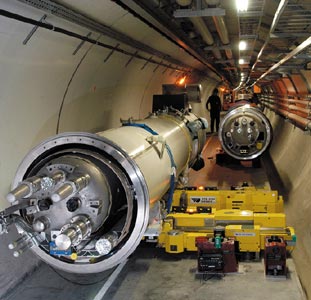
Installation tests in the LHC tunnel in January 2004: a short, straight section is positioned next to a superconducting dipole.
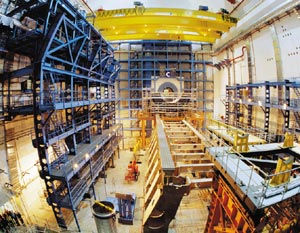
The underground cavern where the detector for ATLAS – one of four major experiments for the LHC – is being installed, in May 2004.

Assembly of the hadron calorimeter for the CMS experiment at the LHC in June 2004.
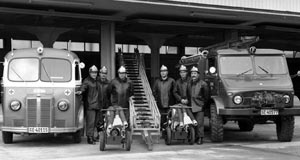
The CERN fire brigade was set up in July 1956 to provide a rapid response in the event of an accident and to tackle the risks specific to the organization’s activities. Here are six members of the brigade in 1959.
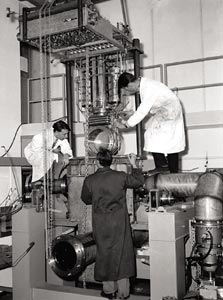
The 30 cm hydrogen bubble chamber, seen here being inserted into its vacuum tank, took its first beam from the SC in 1959 and moved to the PS in 1960.

The upper magnet coil of CERN’s first machine, the Synchrocyclotron (SC), is moved over the upper pole discs. Each coil weighed 60 tonnes and measured 7.2 metres in diameter. The SC was commissioned in 1957 and was operational for 34 years.

During the night of 24 November 1959 the PS reached its full energy. The next morning John Adams announced the achievement in the main auditorium. In his hand is an empty vodka bottle, which he had received from Dubna with the message that it was to be drunk when CERN passed the Synchrophasotron’s world-record energy of 10 GeV. The bottle contained a polaroid photograph of the 24 GeV pulse ready to be sent back to Dubna.
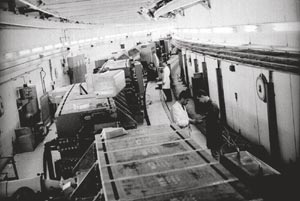
View inside the PS ring in 1964. The PS continues to this day to play a key role in CERN’s accelerator complex.

CESAR (the CERN Electron Storage and Accumulation Ring) was built as a machine model for the ISR. The model had to be small, but the particles had to be relativistic, so electrons were chosen. Running from 1964 to 1967 CESAR demonstrated techniques essential for the ISR (and later the proton-antiproton collider), in particular ultrahigh vacuum techniques.
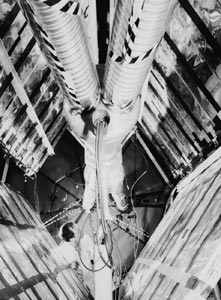
The Intersecting Storage Rings (ISR), the world’s first proton-proton collider, started up in 1971, and later provided the first proton-antiproton collisions and the first collisions of beams of heavier ions (alpha particles). This image shows the vacuum chamber at one of the points where the proton beams crossed in the ISR.

CERN has welcomed many visitors during its 50 years. Here, Richard Feynman gives a lecture in his inimitable style in 1970.
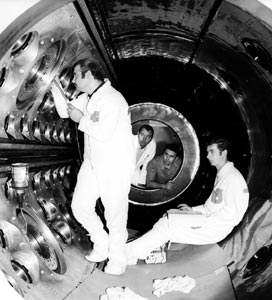
Assembly in progress inside the Gargamelle heavy-liquid bubble chamber, which was built at Saclay in France and came into operation at the PS in 1971. The chamber had a cylindrical body 4.8 m long and 1.85 m wide, with a volume of 12 cubic metres.

In 1973 the Gargamelle collaboration announced the discovery of weak neutral currents. Here in a neutral-current event, a neutrino interacts with an electron in the chamber liquid. The neutrino continues unseen, while the electron creates the horizontal branched track.

In 1968 Georges Charpak (seen here in 1978) invented the multi-wire proportional chamber, which was to revolutionize the field of particle detection and gain him the 1992 Nobel Prize in Physics.

The SPS, with its 7 km circular tunnel, extended CERN beyond the Meyrin site. Construction began in 1972. Here the metal structure of the shuttering used when pouring the concrete walls of the tunnel gives a remarkable optical effect.
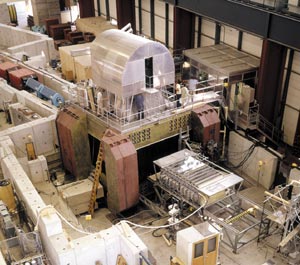
The Omega spectrometer came into action in the West Area at the SPS during 1972. An array of optical spark chambers can be seen withdrawn from the magnet aperture. The “igloo” above the magnet housed the Plumbicon camera system that recorded information from the chambers. No fewer than 48 experiments made use of Omega, exploiting beams of various particles at various energies – first from the PS and then from the higher energy SPS.
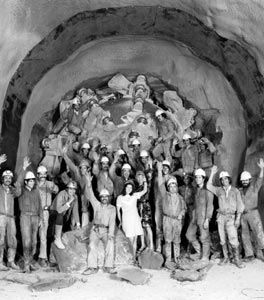
Two years after the construction of the SPS began, on 31 July 1974, the Robbins boring machine that was excavating the tunnel returned to its starting point.
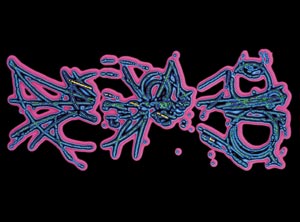
On 21 January 1983 the UA1 collaboration, led by Carlo Rubbia, announced the discovery of the charged carrier of the weak interaction, the W, in proton–antiproton collisions at the SPS. Three months later they had also found the Z0 , responsible for the weak neutral currents discovered 10 years previously in Gargamelle. In this colour-treated picture of tracks reconstructed in UA1, a Z has decayed into an electron and a positron, which fly off in opposite directions (yellow).
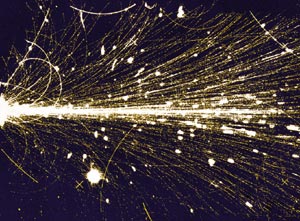
The SPS also had a pioneering role in CERN’s programme of heavy-ion physics, beginning with beams of oxygen and sulphur ions in 1986. Here a sulphur ion, with a total energy of 6400 GeV, strikes a nucleus in a gold target in the NA35 experiment. A streamer chamber records the resulting shower of particles.

In 1984 Carlo Rubbia (centre) and Simon van der Meer (left) received the Nobel prize for the discovery of the W and Z particles at CERN. Here they are talking in 1983 with Sir Alec Merrison, then president of Council.
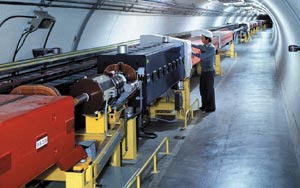
The final stages of preparation in the SPS tunnel in April 1976. The red magnets are some of the 800 or so 6 m long dipole magnets that guide the beams round the machine.

The Antiproton Accumulator, seen here in June 1980, was an important step in converting the SPS to a proton-antiproton collider. It used Simon van der Meer’s “stochastic cooling” technique to produce useful beams of antiprotons.
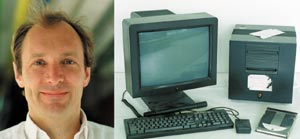
Tim Berners-Lee, seen here in 1994, invented and developed the World Wide Web as an essential tool for high-energy physicists. He conceived HTML, http and URLs using the machine shown on the right in 1990 to develop and run the first Web server, multimedia browser and Web editor.

In 1985 excavation work began for the 27 km tunnel of the Large Electron Positron collider (LEP). This was the most formidable civil-engineering venture in the history of CERN and Europe’s largest civil-engineering project prior to the Channel Tunnel.

One of the monorail trains suspended from the ceiling above the magnet ring in the 27 km long LEP tunnel. The trains were used for transporting goods and people.

Looking rather as if surrounded by a collection of ornate urns, a technician surveys copper-accelerating cavities used in LEP. From 1996 these were gradually replaced by superconducting cavities that were to double the total collision energy from 100 GeV to just over 200 GeV.
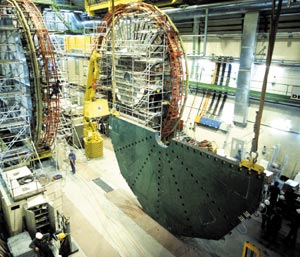
The construction of DELPHI, one of the four detectors at LEP, in January 1989, only seven months before the first collisions. This picture shows the installation of a “half-moon” section for one of the end caps.
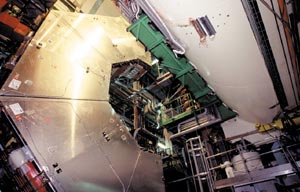
A feature of the L3 experiment at LEP was its huge magnet, with much of the detector located within the magnet coils. One of the huge “doors” of the magnet is seen in this view from February 2000.
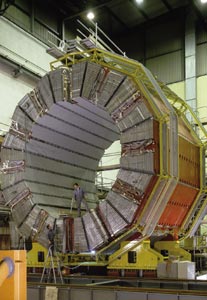
The segmented barrel of the hadron calorimeter for the ALEPH detector at LEP during construction in 1987; the iron also formed the return yoke for the electromagnet.
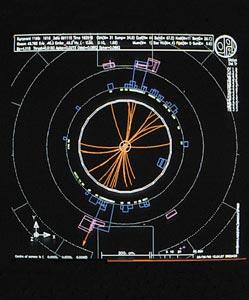
After LEP started operation in August 1989 it became a veritable “factory” for the production of Z0 particles. This display from OPAL shows the decay of a Z into two jets of particles, originating from a quark-antiquark pair, recorded in June 1990.
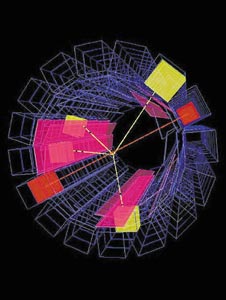
The world’s first atoms of antihydrogen were observed in the PS210 experiment at CERN in 1995. Seven years later in 2002, the ATRAP and ATHENA experiments began to make antihydrogen atoms by the thousand. This display shows an antihydrogen event recorded by ATHENA in August 2002.
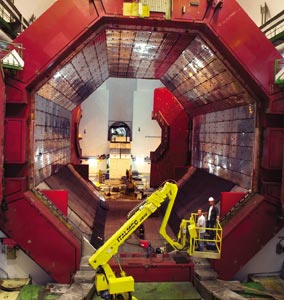
The ALICE experiment, which will study lead-lead collisions in the LHC, is being installed in the cavern previously occupied by the L3 detector. It also makes use of L3’s huge magnet.

The LHCb detector will occupy the cavern used by the DELPHI experiment at LEP, and will investigate matter-antimatter differences in B mesons at the LHC. The coils of the detector’s huge dipole magnet are seen here in April 2004.








